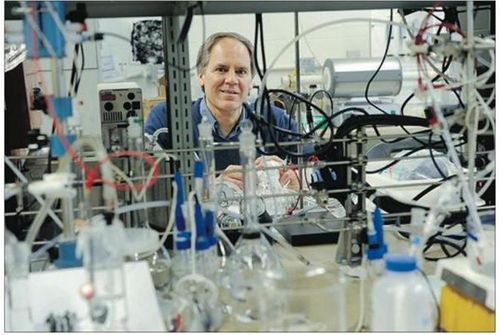
University of B.C. scientists are working to harness the sun's energy to power a process that converts the planet-threatening greenhouse gas carbon dioxide into a useful fuel.
David Wilkinson, executive director of the Clean Energy Research Centre at UBC, says concentrated CO2 emissions from power plants combined with water can be converted to methane, methanol, formic acid and other fuels suitable for combustion or electric cells using known chemical processes.
The concentration of carbon dioxide is rising in the Earth's atmosphere, driving global warming and climate change.
Converting greenhouse gases to a relatively clean fuel allows us to treat a dangerous waste material as a resource, he said.
The National Aeronautics and Space Administration employs a similar kind of process in the life-support systems on the Gemini space missions to create potable water and methane from excess carbon dioxide in the cabin atmosphere.
A larger solar-powered system would be a natural fit for coal-fired plants as well as newgeneration biofuel and gasification plants that have highly concentrated carbon dioxide emissions, he said.
If the technology can then be adapted to work with lower concentrations of carbon dioxide, it could draw greenhouse gases directly from the atmosphere with the potential to improve the air in the world's most polluted cities, Wilkinson said.
The problem is that the energy inputs required to fuel the reaction are enormous.
"Carbon dioxide is a very stable molecule that can spend 400 years in the atmosphere so to break it down you need a lot of energy," Wilkinson said.
Enter the sun.
"We will make use of the energy in solar radiation on a specialized catalyst which breaks down the carbon dioxide in the presence of water to produce fuels," Wilkinson said. The fuels produced are relatively clean burning, in most cases leaving only water and carbon dioxide as byproducts.
"Essentially you'd have an energy cycle that is CO2-neutral," he said.
Wilkinson's work was one of 27 projects granted funds by the Pacific Institute for Climate Solutions, a collaborative venture of B.C.'s major research universities -UBC, Simon Fraser University, the University of Northern B.C. and the University of Victoria. The $1.8 million disbursed Tuesday is drawn from a $90-million endowment for climate research from the province of B.C. granted to the universities in 2008.
"There is a lot of research going on about removing carbon dioxide [from emissions] but this is a new approach and you can actually get utility out of the carbon dioxide," Wilkinson explained.
He plans to create special electrodes -sheets of titanium oxide coated with platinum, copper and other materials -that will act as a catalyst when exposed to solar radiation. The difficulty is in creating microscopically small "nano-structures" in the catalyzing material that are capable of extracting a significant amount of fuel from the process.
The Clean Energy Research Centre hopes to create a technology that can be deployed first on an industrial scale to recover CO2 from power plants and produce carbonneutral fuel, then as a practical method for removing excess carbon dioxide directly from the Earth's atmosphere.
"We really need a breakthrough in the material science before this can be scaled up," Wilkinson said. "But we will also be testing cells and the engineering aspects of solar reduction of carbon dioxide, so that will allow us to apply the material science in a practical way."



Reader Comments
to our Newsletter